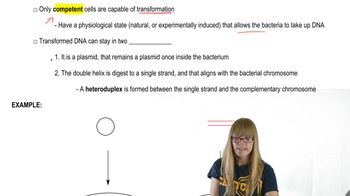Table of contents
- 1. Introduction to Genetics51m
- 2. Mendel's Laws of Inheritance3h 37m
- 3. Extensions to Mendelian Inheritance2h 41m
- 4. Genetic Mapping and Linkage2h 28m
- 5. Genetics of Bacteria and Viruses1h 21m
- 6. Chromosomal Variation1h 48m
- 7. DNA and Chromosome Structure56m
- 8. DNA Replication1h 10m
- 9. Mitosis and Meiosis1h 34m
- 10. Transcription1h 0m
- 11. Translation58m
- 12. Gene Regulation in Prokaryotes1h 19m
- 13. Gene Regulation in Eukaryotes44m
- 14. Genetic Control of Development44m
- 15. Genomes and Genomics1h 50m
- 16. Transposable Elements47m
- 17. Mutation, Repair, and Recombination1h 6m
- 18. Molecular Genetic Tools19m
- 19. Cancer Genetics29m
- 20. Quantitative Genetics1h 26m
- 21. Population Genetics50m
- 22. Evolutionary Genetics29m
7. DNA and Chromosome Structure
DNA as the Genetic Material
Problem 5a
Textbook Question
When Avery and his colleagues had obtained what was concluded to be the transforming factor from the IIIS virulent cells, they treated the fraction with proteases, RNase, and DNase, followed in each case by the assay for retention or loss of transforming ability. What were the purpose and results of these experiments? What conclusions were drawn?
 Verified step by step guidance
Verified step by step guidance1
Step 1: Understand the historical context of the experiment. Avery, MacLeod, and McCarty were building on Griffith's experiment, which demonstrated the transformation of non-virulent bacteria into virulent forms. They aimed to identify the 'transforming principle' responsible for this change.
Step 2: Identify the experimental design. Avery and his team isolated the transforming factor from virulent IIIS cells and treated it with different enzymes: proteases (which degrade proteins), RNase (which degrades RNA), and DNase (which degrades DNA).
Step 3: Analyze the purpose of using these enzymes. The goal was to determine which macromolecule was responsible for the transformation. If the transforming ability was lost after treatment with a specific enzyme, it would suggest that the macromolecule targeted by that enzyme was the transforming factor.
Step 4: Examine the results of the enzyme treatments. After treatment with proteases and RNase, the transforming ability was retained, indicating that proteins and RNA were not responsible for the transformation. However, treatment with DNase resulted in the loss of transforming ability, suggesting that DNA was the transforming factor.
Step 5: Draw conclusions from the experiment. The results led Avery and his colleagues to conclude that DNA is the genetic material responsible for transformation, providing strong evidence that DNA carries genetic information.
Recommended similar problem, with video answer:
 Verified Solution
Verified SolutionThis video solution was recommended by our tutors as helpful for the problem above
Video duration:
1mPlay a video:
Was this helpful?
Key Concepts
Here are the essential concepts you must grasp in order to answer the question correctly.
Transforming Principle
The transforming principle refers to the substance responsible for genetic transformation, which was identified by Avery and his colleagues as DNA. In their experiments, they demonstrated that DNA from virulent IIIS cells could transform non-virulent IIR cells into virulent forms, indicating that DNA carries genetic information.
Recommended video:
Guided course

Transformation
Enzymatic Treatment
Avery's team used specific enzymes—proteases, RNase, and DNase—to treat the transforming factor. Proteases degrade proteins, RNase degrades RNA, and DNase degrades DNA. By observing which treatments resulted in the loss of transforming ability, they could determine which macromolecule was responsible for the transformation.
Recommended video:
Guided course

Cancer Characteristics
Conclusion of Avery's Experiments
The results of Avery's experiments showed that only the treatment with DNase led to the loss of transforming ability, confirming that DNA was the transforming factor. This pivotal conclusion provided strong evidence that DNA, not protein or RNA, is the genetic material in organisms, laying the groundwork for modern genetics.
Recommended video:
Guided course

Mendel's Experiments

 9:32m
9:32mWatch next
Master History and Experiments with a bite sized video explanation from Kylia Goodner
Start learningRelated Videos
Related Practice


